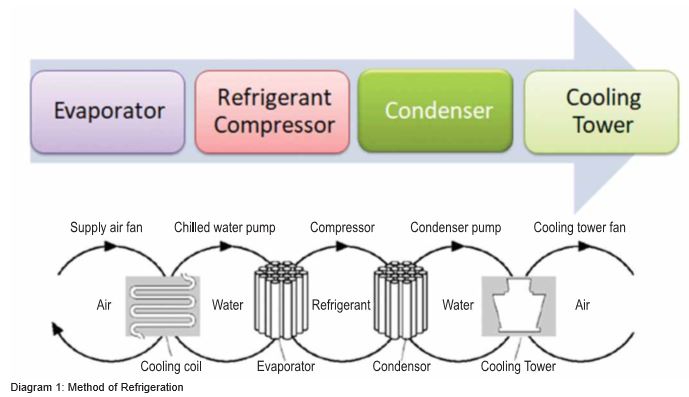Introduction
The Heating, Ventilation and Air Conditioning (HVAC) and refrigeration system transfers the heat energy from or to the products, or building environment. Energy in form of electricity or heat is used to power mechanical equipment designed to transfer heat from a colder, low-energy level to a warmer, high-energy level.
Refrigeration deals with the transfer of heat from a low temperature level at the heat source to a high temperature level at the heat sink by using a low boiling refrigerant.
There are several heat transfer loops in refrigeration system as described below:

In the Figure 1, thermal energy moves from left to right as it is extracted from the space and expelled into the outdoors through five loops of heat transfer:
Air-Conditioning Systems
Depending on applications, there are several types of air-conditioning systems:
- Air Conditioning (for comfort / machine)
- Split air conditioners
- Fan coil units in a larger system
- Air handling units in a larger system
Refrigeration Systems (for processes)
In many industrial processed refrigeration system are needed. Different technologies are used for different applications:
- Small capacity modular units of direct expansion type similar to domestic refrigerators, small capacity refrigeration units.
- Centralized chilled water plants with chilled water as a secondary coolant for temperature range over 50C typically. They can also be used for ice bank formation.
- Brine plants, which use brines as lower temperature, secondary coolant, for typically sub zero temperature applications, which come as modular unit capacities as well as large centralized plant capacities.
- The plant capacities upto 50 TR are usually considered as small capacity, 50 – 250 TR as medium capacity and over 250 TR as large capacity units.
A large industry may have a bank of such units, often with common chilled water pumps, condenser water pumps, cooling towers, as an off site utility.
The same industry may also have two or three levels of refrigeration & air conditioning such as:
- Comfort air conditioning (200 – 250 C)
- Chilled water system (80 – 100 C)
- Brine system (sub-zero applications)
Electricity is the main energy type used for operation of refrigeration and air-conditioning system.
Design & Operation
Two principle types of refrigeration plants found in industrial use are:
- Vapour Compression Refrigeration (VCR) and
- Vapour Absorption Refrigeration (VAR).
VCR uses mechanical energy as the driving force for refrigeration, while VAR uses thermal energy as the driving force for refrigeration.
Vapour Compression Refrigeration (VCR)
Heat flows naturally from a hot to a colder body. In refrigeration system the opposite must occur i.e. heat flows from a cold to a hotter body. This is achieved by using a substance called a refrigerant, which absorbs heat and hence boils or evaporates at a low pressure to form a gas. This gas is then compressed to a higher pressure, such that it transfers the heat it has gained to ambient air or water and turns back (condenses) into a liquid. In this way heat is absorbed, or removed, from a low temperature source and transferred to a higher temperature source. The refrigeration cycle can be broken down into the following stages as shown in the figure.

Alternative Refrigerants for Vapour Compression Systems
The use of CFCs is now beginning to be phased out due to their damaging impact on the protective tropospheric ozone layer around the earth. The Montreal Protocol of 1987 and the subsequent Copenhagen agreement of 1992 mandate a reduction in the production of ozone depleting Chlorinated Fluorocarbon (CFC) refrigerants in a phased manner, with an eventual stop to all production by the year 1996. In response, the refrigeration industry has developed two alternative refrigerants; one based on Hydrochloro Fluorocarbon (HCFC), and another based on Hydro Fluorocarbon (HFC). The HCFCs have a 2 to 10% ozone depleting potential as compared to CFCs and also, they have an atmospheric lifetime between 2 to 25 years as compared to 100 or more years for CFCs (Brandt, 1992). However, even HCFCs are mandated to be phased out by 2005, and only the chlorine free (zero ozone depletion) HFCs would be acceptable.
Until now, only one HFC based refrigerant, HFC 134a, has been developed. HCFCs are comparatively simpler to produce and the three refrigerants 22, 123, and 124 have been developed. The use of HFCs and HCFCs results in slightly lower efficiencies as compared to CFCs, but this may change with increasing efforts being made to replace CFCs.
Vapour Absorption Refrigeration (VAR)
The absorption chiller is a machine, which produces chilled water by using heat such as steam, hot water, gas, oil etc. Chilled water is produced by the principle that liquid (refrigerant), which evaporates at low temperature, absorbs heat from surrounding when it evaporates. Pure water is used as refrigerant and lithium bromide solution is used as absorbent.
Heat for the vapour absorption refrigeration system can be provided by waste heat extracted from process, diesel generator sets etc. Absorption systems require electricity to run pumps only. Depending on the temperature required and the power cost, it may even by economical to generate heat or steam to operate the absorption system.



